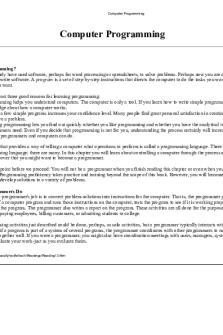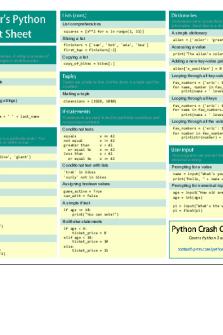Python cheat code for python programming PDF

| Title | Python cheat code for python programming |
|---|---|
| Course | PYTHON |
| Institution | Lovely Professional University |
| Pages | 26 |
| File Size | 1.8 MB |
| File Type | |
| Total Downloads | 54 |
| Total Views | 603 |
Summary
Variables are used to store values. A string is a series of characters, surrounded by single or double quotes.Hello worldprint("Hello world!")Hello world with a variablemsg = "Hello world!" print(msg)Concatenation (combining strings)first_name = 'albert' last_name = 'einstein' full_name = first_name...
Description
Dictionaries store connections between pieces of information. Each item in a dictionary is a key-value pair.
List comprehensions squares = [x**2 for x in range(1, 11)]
Slicing a list
alien = {'color': 'green', 'points': 5}
finishers = ['sam', 'bob', 'ada', 'bea'] first_two = finishers[:2] Variables are used to store values. A string is a series of characters, surrounded by single or double quotes.
copy_of_bikes = bikes[:]
Concatenation (combining strings) first_name = 'albert' last_name = 'einstein' full_name = first_name + ' ' + last_name print(full_name)
Looping through all key-value pairs Tuples are similar to lists, but the items in a tuple can't be modified.
Making a tuple dimensions = (1920, 1080)
If statements are used to test for particular conditions and respond appropriately.
Conditional tests A list stores a series of items in a particular order. You access items using an index, or within a loop.
Make a list bikes = ['trek', 'redline', 'giant']
equals not equal greater than or equal to less than or equal to
x x x x x x
== 42 != 42 > 42 >= 42 < 42 = 18: print("You can vote!")
fav_numbers = {'eric': 17, 'ever': 4} for name, number in fav_numbers.items(): print(name + ' loves ' + str(number))
Looping through all keys fav_numbers = {'eric': 17, 'ever': 4} for name in fav_numbers.keys(): print(name + ' loves a number')
Looping through all the values fav_numbers = {'eric': 17, 'ever': 4} for number in fav_numbers.values(): print(str(number) + ' is a favorite')
Your programs can prompt the user for input. All input is stored as a string.
Prompting for a value name = input("What's your name? ") print("Hello, " + name + "!")
Prompting for numerical input age = input("How old are you? ") age = int(age) pi = input("What's the value of pi? ") pi = float(pi)
If-elif-else statements if age < 4: ticket_price = 0 elif age < 18: ticket_price = 10 else: ticket_price = 15
Covers Python 3 and Python 2
A while loop repeats a block of code as long as a certain condition is true.
A simple while loop current_value = 1 while current_value...
Similar Free PDFs

Python-Cheat-Sheet - python
- 14 Pages

Programming with python-3
- 82 Pages

Computer Programming python
- 15 Pages

Numpy Python Cheat Sheet
- 1 Pages

Lab04 - Python Programming.
- 11 Pages

Python Cheat Sheet 2
- 26 Pages

Beginners python cheat sheets
- 28 Pages

Python Matplotlib Cheat Sheet
- 1 Pages

Beginners python cheat sheet
- 26 Pages

Python Turtle cheat sheets
- 5 Pages

Python seaborn cheat sheet
- 1 Pages
Popular Institutions
- Tinajero National High School - Annex
- Politeknik Caltex Riau
- Yokohama City University
- SGT University
- University of Al-Qadisiyah
- Divine Word College of Vigan
- Techniek College Rotterdam
- Universidade de Santiago
- Universiti Teknologi MARA Cawangan Johor Kampus Pasir Gudang
- Poltekkes Kemenkes Yogyakarta
- Baguio City National High School
- Colegio san marcos
- preparatoria uno
- Centro de Bachillerato Tecnológico Industrial y de Servicios No. 107
- Dalian Maritime University
- Quang Trung Secondary School
- Colegio Tecnológico en Informática
- Corporación Regional de Educación Superior
- Grupo CEDVA
- Dar Al Uloom University
- Centro de Estudios Preuniversitarios de la Universidad Nacional de Ingeniería
- 上智大学
- Aakash International School, Nuna Majara
- San Felipe Neri Catholic School
- Kang Chiao International School - New Taipei City
- Misamis Occidental National High School
- Institución Educativa Escuela Normal Juan Ladrilleros
- Kolehiyo ng Pantukan
- Batanes State College
- Instituto Continental
- Sekolah Menengah Kejuruan Kesehatan Kaltara (Tarakan)
- Colegio de La Inmaculada Concepcion - Cebu




